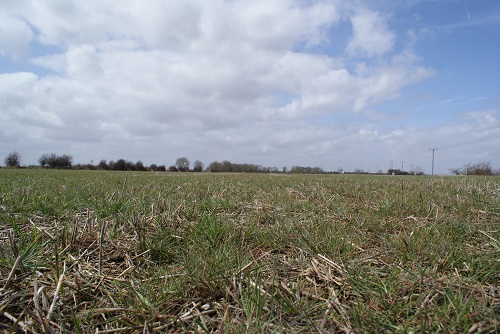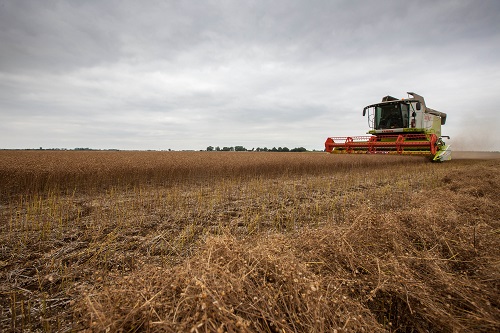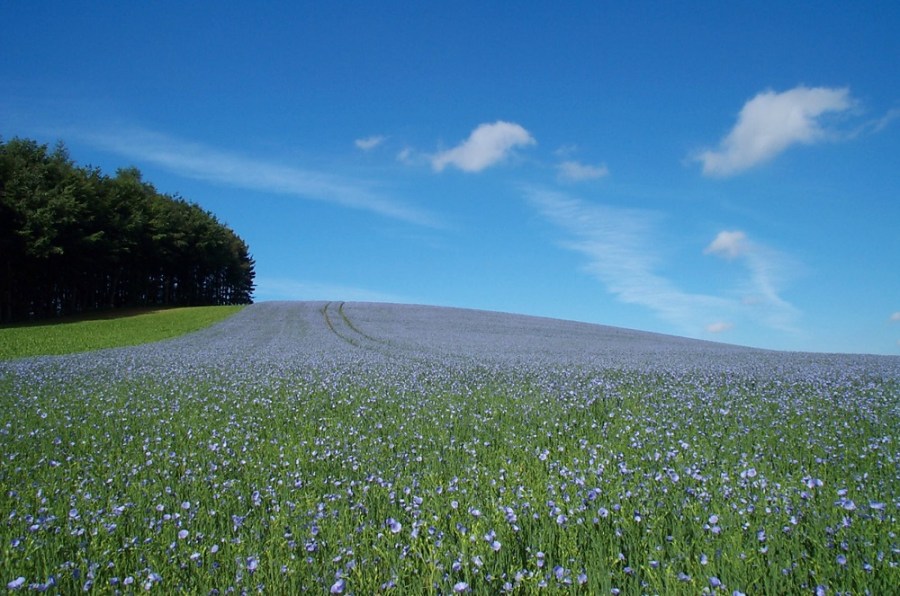Its blue flowers have been seen painting the landscape once again in early summer, but many of those growing the crop simply don’t want to talk about it, just in case everyone wants a piece of the action. CPM finds out what’s fuelling the linseed revival.
Linseed can be the ideal break crop, with the following wheat crops noticeably cleaner.
By Lucy de la Pasture
The spring crop back on the ascendency is linseed. The latest Defra June survey statistics showed linseed had a dramatic surge in popularity in 2016, increasing by a massive 81.6% to 27,000ha. Still a long way off the area planted in linseed’s halcyon days, but is the upward trend likely to continue?
Spring linseed is seeing an upsurge in planting because it ticks a lot of boxes, believes Nigel Padbury, Premium Crops seeds and marketing manager.
Blackgrass control
“One of the factors fuelling the return to spring cropping in the rotation is blackgrass control. Linseed is a crop that’s comparatively late drilling, usually in April, so gives growers the opportunity to burn off any flushes of blackgrass before planting,” he says.

Spring linseed is seeing an upsurge in planting because it ticks a lot of boxes, believes Nigel Padbury.
A blackgrass problem has prompted one Worcs grower to plan to plant 45ha of spring linseed in 2017, says AICC agronomist, David Lines.
“They’ve grown linseed before and have had really good results. Linseed can be the ideal break crop, with the following wheat crops noticeably cleaner,” he says. “The real advantage on the blackgrass-infested land is a later drilling window which gives plenty of time to produce a stale seedbed.”
The plan leading up to drilling is to leave the fields, which were shallow cultivated in the autumn, over the winter period. Two flushes of blackgrass were destroyed with glyphosate leading up to Dec and any further flush will receive a third treatment pre-drilling in the spring, he explains.
“We’ll plant as late as we can, using a Weaving drill so that there’s little to no soil disturbance. One of the advantages of spring linseed in a blackgrass situation is that Centurion Max (clethodim) can be used.
“Contact graminicides tend to work much better when applied in the spring. This is possibly partly due to the weather conditions, but mostly because blackgrass flushes in the spring tend to be rapid. That means it’s easier to target small blackgrass plants that have a far less protracted period of emergence than in the autumn,” he notes.
Tracking ryegrass
In David Lines’ region, ryegrass is becoming as much of a problem as blackgrass in some fields and he believes there’s a need to start tackling ryegrass with the same seriousness as its more infamous grassweed relative.

Usually drilled in April, linseed gives growers the opportunity to burn off any flushes of blackgrass before planting.
“Fields are being put into a short-term grass ley as a break but are often planted with the rapid-growing Westerwolds Italian ryegrass for silage crops. When the grass goes back into the cereal rotation, Westerwolds ryegrass weeds produce even more of a problem to manage than blackgrass,” he adds.
But blackgrass control isn’t the sole reason linseed is once again being considered by growers as a reliable spring cropping option, adds Nigel Padbury.
“The gross margin achievable stands on its own two feet, with projected figures for 2017 of £533/ha. That’s respectfully competitive with spring wheat for milling at £553/ha and outperforming spring oilseed rape at £458/ha. What’s more, the margin from linseed stands head and shoulders above the popular spring pulse options, with blue peas producing a forecast margin of £259/ha and feed beans £296/ha for next harvest.

Modern varieties have moved on a long way from the days of late harvests and difficult combining.
“The average yield of spring linseed is 2.5t/ha and many achieve well over 3t/ha. With a price per tonne of £350+ for harvest 2017, the economics stack up,” he adds.
For those ex-linseed growers who have memories of late harvests and difficult combining, modern varieties have moved on a long way and many of those stories arise from times when subsidy terms gave growers little incentive to manage the crop correctly, assures Nigel Padbury.
“A well managed crop of linseed will be ready to harvest shortly after the wheat and combining is much quicker and easier. If lateness of harvest is a concern, then Easycut varieties are available that are both earlier to harvest and easy to combine,” he adds.
David Lines reckons that bad memories of harvesting linseed are one of the reasons it’s taken a while for the crop to return as a contender in spring cropping plans.
“Linseed had a reputation for being late to harvest and could be problematic to combine but patience is the key. Linseed won’t shed so that’s not a problem but you can’t force it. The combine will tell you in the first five yards whether it’s fit to harvest or not,” he says.
Growing winter linseed is another option that’s increasing in popularity again as growers look for an alternative to winter OSR, comments Nigel Padbury.
Winter linseed
“The area of winter linseed has gone up again for harvest 2017, with 2500ha in the ground, as grower confidence increases in the crop. There used to be issues with winter linseed but breeders have moved the crop on to mitigate these problems,” he says.
“Our linseed agronomist, Sam Deane, is doing a lot of work with PGRs in the winter crop and has developed a protocol for managing the canopy, in a similar way to canopy management in OSR. He’s found that early nitrogen is just feeding the stem and not adding to yield so it’s important not to rush to apply nitrogen in the spring. Nitrogen inputs after Christmas is an area we’re looking very carefully at.”
There are several different types of linseed that can be grown, each with slightly different contract terms, explains Nigel Padbury.
“Brown linseed is the type most people are familiar with and the Easycut varieties are all found in this category. More specialist types are the ultra-high Omega 3s, which have a premium of £25/t over the £350/t expected for brown linseed, and yellow linseed which, as its name suggests, produces a yellow-coloured seed.
“The ultra-high Omega 3 varieties have medium-early maturity and good standing power. We supply ultra-high Omega 3 linseed to Valorex, a French animal feed company. Livestock fed on linseed-based feeds (known as “Tradilin” in France) produce meat and milk with improved Omega 3 content,” he explains.
In addition to the pet food and bird seed markets, yellow linseed is destined for human consumption in muesli bars and health foods. The food industry prefers yellow linseed for its colour and shiny finish, explains Nigel.
“It’s a market that we’ve supplied for many years and we continue to explore opportunities,” he adds.
There’s a premium for yellow linseed over and above the brown linseed price, although some growers simply prefer to grow it because they know exactly where their crop is going. The conventional brown contract, where the seed is usually processed for oil, is much less specific.”
A good fit in the rotation
John Ashton of Ashton Bros farms 182ha near Spalding in Lincs. His land has two soil types, with light silts ideal for carrot and potato production and heavy clay, which is in a traditional rotation of winter wheat, OSR, winter wheat, spring linseed. Spring barley is increasingly finding a place in the rotation to help with blackgrass control, he explains.
He’s grown linseed on and off since 1993 and reckons the linseed of today is a world apart from the linseed of yesteryear.
As a specialist seed grower, John has been growing the spring variety of linseed, Marquise, for seed on contract to Premium Crops since 2014 and has become a fan of the crop, growing an increased acreage each year.
Compared with other spring crops, he finds linseed fits well into the rotation and always combines before spring beans. Marquise is an Easycut variety which he can ‘fly through’ with the combine and this year his 24ha was safely in storage before the Aug bank holiday.
“We find that if we’re rained off from combining, the linseed dries much quicker than the wheat and we can often get back into the linseed with the combine before the wheat is fit again,” he adds.
Blackgrass is a weed that few farms in the area are without and there’s no doubt that spring cropping provides an opportunity to reduce the burden, says John Ashton.
“Winter cropping is often blamed for the blackgrass problem we have today but when I looked back at my crop diaries, I first reported blackgrass on this farm in 1973. At that time, two-thirds of the farm was in spring cropping so blackgrass got in before there was a big move to winter cropping.”
He finds linseed works as a good cleaning crop in his rotation, with a reduced amount of blackgrass to contend with in land that was previously in linseed.
“This autumn there was a noticeable difference in the amount of blackgrass emerging on the ploughed ground, with very little where linseed had been grown four years ago. Linseed provides a good entry into wheat, we cut it as low as we can, push the straw up into a heap and then burn it.
“The linseed also acts as a soil conditioner so we only use a sub-soiler or soil packer and direct drill wheat into the linseed stubble, making use of the tilth created in the spring. The roots of the linseed break up the soil really well,” he comments.
The drier conditions under the linseed crop means it doesn’t provide great conditions for slugs to thrive.
“We’ve never seen a slug in the wheat following linseed, however wet it gets, which is a real benefit on our strong land where slugs are a real problem after OSR,” he adds.
When it comes to establishing his linseed crop in the spring, blackgrass control is again at the forefront of his cultivation strategy.
“We plough early in the autumn, under good conditions before we start autumn drilling. We then level the ground using either a press or land packer and if the plough greens up, we spray it off. In the spring, we stale seedbed again to catch any blackgrass that’s germinated over the winter/early spring.
“We then put a Wilder pressure harrow across the field before drilling with our Väderstad drill. Lastly we roll to firm it up so we get good seed-to-soil contact, encouraging even and rapid germination. Swift emergence makes it much less likely flea beetle will have an impact on the crop,” he explains.
“We use triallate granules (Avadex) as a pre-emergence herbicide for blackgrass control and try not to use Centurion Max so that it maintains activity for use in OSR on the farm,” he concludes.




